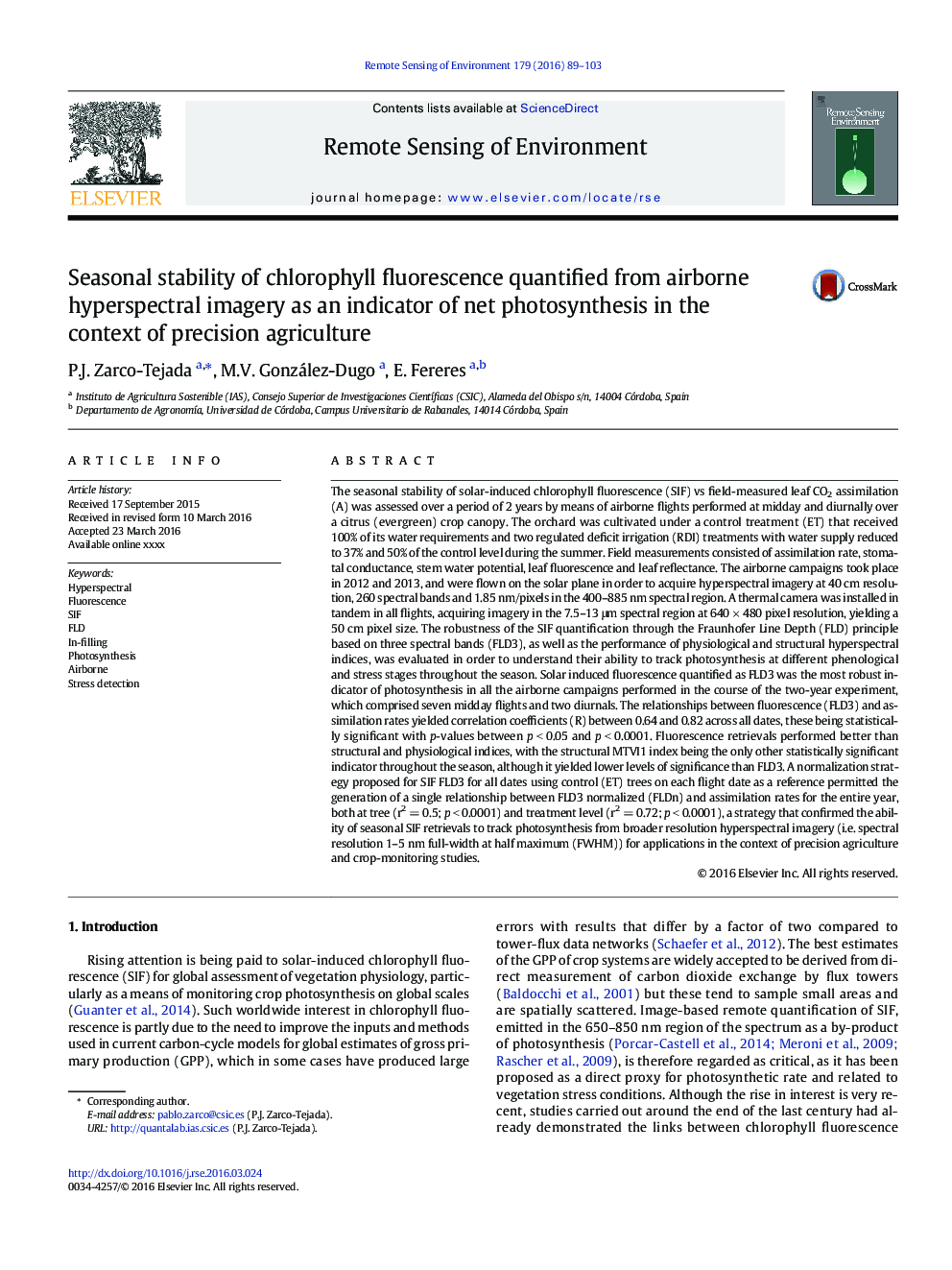| کد مقاله | کد نشریه | سال انتشار | مقاله انگلیسی | نسخه تمام متن |
|---|---|---|---|---|
| 6345467 | 1621221 | 2016 | 15 صفحه PDF | دانلود رایگان |
عنوان انگلیسی مقاله ISI
Seasonal stability of chlorophyll fluorescence quantified from airborne hyperspectral imagery as an indicator of net photosynthesis in the context of precision agriculture
ترجمه فارسی عنوان
پایداری فصلی فلورسانس کلروفیل، از تصاویری از هیتر اسپکتروویو هوائی به عنوان شاخصی از فتوسنتز خالص در زمینه کشاورزی دقت
دانلود مقاله + سفارش ترجمه
دانلود مقاله ISI انگلیسی
رایگان برای ایرانیان
کلمات کلیدی
موضوعات مرتبط
مهندسی و علوم پایه
علوم زمین و سیارات
کامپیوتر در علوم زمین
چکیده انگلیسی
The seasonal stability of solar-induced chlorophyll fluorescence (SIF) vs field-measured leaf CO2 assimilation (A) was assessed over a period of 2 years by means of airborne flights performed at midday and diurnally over a citrus (evergreen) crop canopy. The orchard was cultivated under a control treatment (ET) that received 100% of its water requirements and two regulated deficit irrigation (RDI) treatments with water supply reduced to 37% and 50% of the control level during the summer. Field measurements consisted of assimilation rate, stomatal conductance, stem water potential, leaf fluorescence and leaf reflectance. The airborne campaigns took place in 2012 and 2013, and were flown on the solar plane in order to acquire hyperspectral imagery at 40 cm resolution, 260 spectral bands and 1.85 nm/pixels in the 400-885 nm spectral region. A thermal camera was installed in tandem in all flights, acquiring imagery in the 7.5-13 μm spectral region at 640 Ã 480 pixel resolution, yielding a 50 cm pixel size. The robustness of the SIF quantification through the Fraunhofer Line Depth (FLD) principle based on three spectral bands (FLD3), as well as the performance of physiological and structural hyperspectral indices, was evaluated in order to understand their ability to track photosynthesis at different phenological and stress stages throughout the season. Solar induced fluorescence quantified as FLD3 was the most robust indicator of photosynthesis in all the airborne campaigns performed in the course of the two-year experiment, which comprised seven midday flights and two diurnals. The relationships between fluorescence (FLD3) and assimilation rates yielded correlation coefficients (R) between 0.64 and 0.82 across all dates, these being statistically significant with p-values between p < 0.05 and p < 0.0001. Fluorescence retrievals performed better than structural and physiological indices, with the structural MTVI1 index being the only other statistically significant indicator throughout the season, although it yielded lower levels of significance than FLD3. A normalization strategy proposed for SIF FLD3 for all dates using control (ET) trees on each flight date as a reference permitted the generation of a single relationship between FLD3 normalized (FLDn) and assimilation rates for the entire year, both at tree (r2 = 0.5; p < 0.0001) and treatment level (r2 = 0.72; p < 0.0001), a strategy that confirmed the ability of seasonal SIF retrievals to track photosynthesis from broader resolution hyperspectral imagery (i.e. spectral resolution 1-5 nm full-width at half maximum (FWHM)) for applications in the context of precision agriculture and crop-monitoring studies.
ناشر
Database: Elsevier - ScienceDirect (ساینس دایرکت)
Journal: Remote Sensing of Environment - Volume 179, 15 June 2016, Pages 89-103
Journal: Remote Sensing of Environment - Volume 179, 15 June 2016, Pages 89-103
نویسندگان
P.J. Zarco-Tejada, M.V. González-Dugo, E. Fereres,
